 W
WAphonopelma moderatum is a species of spider in the family Theraphosidae, found in United States (Texas). Commonly called the Rio Grande gold tarantula as they are found in the Rio Grand Valley of Texas.
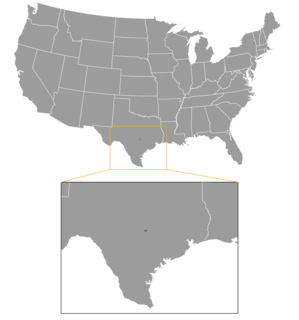 W
WThe Austin blind salamander is an endangered species of salamander in the family Plethodontidae, endemic to Barton Springs in Austin, Texas, United States. Its name is derived from Waterloo, the original name of Austin.
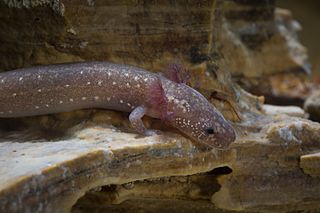 W
WThe Barton Springs salamander is an endangered lungless salamander. It is endemic to Texas, United States. It was first found in Barton Springs in Austin, but is now also known from other localities in the nearby Travis and Hays Counties. Barton Springs salamanders are average-sized and have mottled coloration varying from darkish purple to light yellow.
 W
WThe Guadalupe bass is a rare species of fish endemic to the U.S. state of Texas, where it also is the official state fish. It is restricted to creeks and rivers, and is listed as near threatened. Today, most fly fishermen and anglers practice catch-and-release techniques to improve fish populations. The Guadalupe bass is often difficult to distinguish from the smallmouth bass or spotted bass, and the fish is known to hybridize.
 W
WThe Clear Creek gambusia is a species of fish in the family Poeciliidae endemic to the United States, particularly Menard County, Texas.
 W
WThe Comanche Springs pupfish is a species of pupfish in the family Cyprinodontidae. It is endemic to Texas, and is now found only in spring-fed pools near Balmorhea, a small town in West Texas.
 W
WCyprinodon rubrofluviatilis, known as the Red River pupfish, is a species of pupfish from the United States. It is found only in the Red River of the South and Brazos River drainages of Texas and Oklahoma.
 W
WThe fountain darter is a species of freshwater ray-finned fish, a darter from the subfamily Etheostomatinae, part of the family Percidae, which also contains the perches, ruffes and pikeperches. It is found in the headwaters of only two rivers in Texas, United States: the Comal River and the San Marcos River. It is generally smaller than 3 cm (1.2 in) long and feeds on small invertebrates. It is a federally listed endangered species of the United States and is also listed as endangered by the IUCN.
 W
WThe Franklin Mountain woodland snail is a species of land snail in the family Polygyridae. It is native to New Mexico and Texas in the United States.
 W
WThe Rio Grande leopard frog is a species of aquatic frog native to the southern United States in Texas and New Mexico, and south through Mexico and Central America. It is also sometimes referred to as the Mexican leopard frog. The epithet berlandieri is in honor of the naturalist Jean Louis Berlandier, who worked for the Mexican government on one of the first biological surveys of Texas.
 W
WGammarus pecos, commonly known as the Pecos amphipod, is a species of crustacean in family Gammaridae. It is endemic to Pecos County, Texas in the United States, where it is known from only two locations: Diamond Y Spring and Leon Creek.
 W
WThe Georgetown salamander, also known as the San Gabriel Springs salamander, is a species of salamander in the family Plethodontidae. It is endemic to springs in Williamson County, Texas, near Lake Georgetown. It inhabits freshwater springs and, possibly, caves. It is threatened by habitat loss. Many of the springs where this species formerly lived have been destroyed by development, including creation of Lake Georgetown. The specific name refers to the few remaining remnants of habitat for this species.
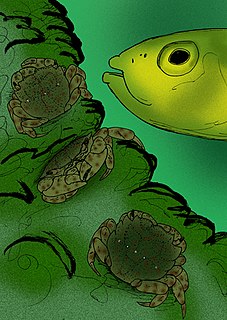 W
WHemigrapsus estellinensis is an extinct species of crab, formerly endemic to the Texas Panhandle. It was discovered by Gordon C. Creel in 1962 and was probably already extinct before his description was published in 1964, after the Estelline Salt Springs where it lived were contained by the United States Army Corps of Engineers. H. estellinensis is closely related to species from the Pacific Ocean such as Hemigrapsus oregonensis, but lived 800 km (500 mi) inland in a hypersaline spring. It differed from its relatives by the pattern of spots on its back, and by the relative sizes of its limbs.
 W
WHeterelmis comalensis is a rare species of beetle known by the common name Comal Springs riffle beetle. It is endemic to Texas in the United States, where it occurs in only two springs. It is a federally listed endangered species of the United States.
 W
WThe Houston toad is an endangered species of amphibian that is endemic to Texas in the United States. This toad was discovered in the late 1940s and named in 1953. Official estimates are that just 3,000–4,000 adult Houston toads are left in the world.
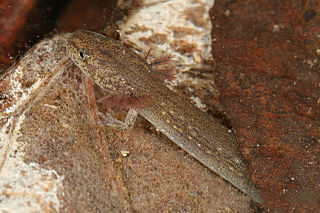 W
WThe Jollyville Plateau salamander is a species of salamander in the family Plethodontidae. It is also known as the Tonkawa Springs salamander. It is endemic to Travis and Williamson counties, Texas, United States. This species is perrenibranchiate, retaining its gills throughout life.
 W
WThe Kretschmarr Cave mold beetle is a small mold beetle.
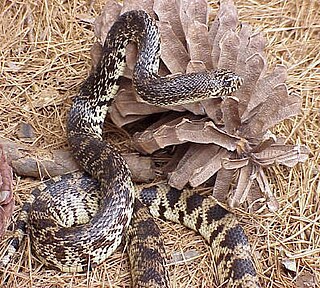 W
WThe Louisiana pine snake is a species of large, nonvenomous constrictor of the family Colubridae. This powerful snake is notable because of its large eggs and small clutch sizes. The Louisiana pine snake is indigenous to west-central Louisiana and East Texas, where it relies strongly on Baird's pocket gophers for its burrow system and as a food source. The Louisiana pine snake is rarely seen in the wild, and is considered to be one of the rarest snakes in North America. The demise of the species is due to its low fecundity coupled with the extensive loss of suitable habitat - the longleaf pine savannas in the Gulf coastal plain of the southeastern United States. Management activities are being conducted to promote the species' recovery.
 W
WThe Devils River minnow is a species of ray-finned fish in the family Cyprinidae. The minnow coexists with other closely related species and other cyprinids in the range of northern Mexico and southern Texas.
 W
WThe Pecos pupfish is a species of pupfish in the family Cyprinodontidae. It is endemic to the Pecos River watershed in eastern New Mexico and western Texas in the United States.
 W
WThe western slimy salamander, also known as the whitethroat slimy salamander or white-throated slimy salamander is a species of salamander. It is endemic to the United States of America and found in two disjunct populations, one from Missouri to Oklahoma, and Arkansas, and another in south-central Texas.
 W
WThe western slimy salamander, also known as the whitethroat slimy salamander or white-throated slimy salamander is a species of salamander. It is endemic to the United States of America and found in two disjunct populations, one from Missouri to Oklahoma, and Arkansas, and another in south-central Texas.
 W
WRhadine persephone is a rare species of beetle known by the common name Tooth Cave ground beetle. It is endemic to Texas in the United States, where it occurs in a network of caves outside Austin. It is a federally listed endangered species of the United States.
 W
WThe San Marcos salamander is a small species of aquatic, lungless salamander native to the United States, endemic to Spring Lake and a small region of the headwaters of the San Marcos River near Aquarena Springs, in Hays County, Texas. It is one to two inches long, with a slender body and external gills, and is a reddish-brown in color.
 W
WThe Chihuahua shiner is a species of freshwater ray-finned fish from the family Cyprinidae, the carps and minnows. It is found in southern Texas and northern Mexico.
 W
WThe sharpnose shiner is a species of ray-finned fish in the family Cyprinidae, the carps and minnows. It is endemic to Texas in the United States, where it is limited to the upper Brazos River basin. In 2013 it became a candidate for federal listing as an endangered species of the United States.
 W
WThe Tamaulipas shiner is a small North American freshwater fish, living in the Rio Grande drainage in Texas and northern Mexico.
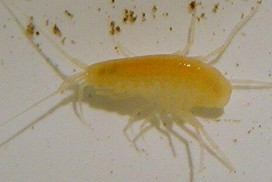 W
WStygobromus pecki is a rare species of crustacean known by the common name Peck's cave amphipod. It is endemic to Texas in the United States, where lives in only two springs in Comal County. It is a federally listed endangered species of the United States, and is listed as Endangered on the IUCN Red List.
 W
WStygoparnus is a monotypic genus of beetles containing the single species Stygoparnus comalensis, which is known by the common name Comal Springs dryopid beetle. This rare beetle is endemic to Texas in the United States, where it is known from two springs. It is a federally listed endangered species of the United States.
 W
WTartarocreagris texana is a species of arachnid in family Neobisiidae. It is endemic to Texas in the United States, where it is known from only two caves in Travis County. It is a federally listed endangered species of the United States.
 W
WTayshaneta microps, synonym Neoleptoneta microps, is a rare species of spider in the family Leptonetidae known by the common name Government Canyon bat cave spider. It is endemic to Texas in the United States, where it is known from two caves in Bexar County. It is a troglobite, an animal which spends its entire life in caves. It is one of nine Bexar County troglobites which were listed as endangered species in 2000.
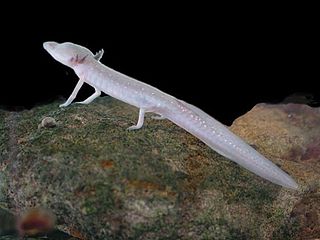 W
WThe Texas blind salamander is a rare cave-dwelling troglobite amphibian native to San Marcos, Hays County, Texas, specifically the San Marcos Pool of the Edwards Aquifer.
 W
WThe Texas garter snake is a subspecies of the common garter snake endemic to the United States.
 W
WThe Texas river cooter is a species of freshwater turtle endemic to the U.S. state of Texas. It is found in the river basins of the Brazos, San Bernard, Colorado, Guadalupe, San Antonio, Nueces, and their tributaries. It is one of three species of cooters (Pseudemys) occurring in Texas, including the Rio Grande cooter and the river cooter.
 W
WTexella reyesi is a rare species of arachnid known by the common name Bone Cave harvestman. It is endemic to Texas in the United States, where it lives in limestone caves in Travis and Williamson Counties. It is threatened by the loss of its habitat. It is a federally listed endangered species of the United States.
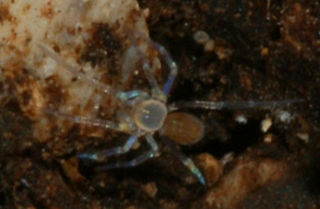 W
WThe Tooth Cave spider, formerly Neoleptoneta myopica, now Tayshaneta myopica, is a 1.6 mm long spider in the family Leptonetidae. It is endemic to limestone caves near Austin, Texas in the United States and is considered an endangered species.
 W
WThe widemouth blindcat is a species of North American freshwater catfish endemic to Texas in the United States. It is the only representative of the genus Satan.